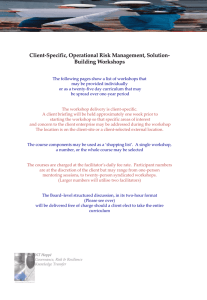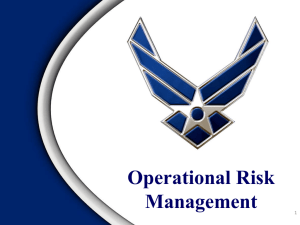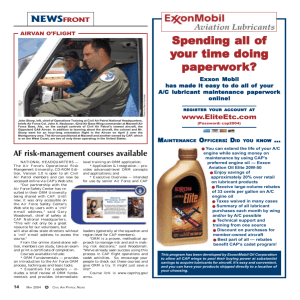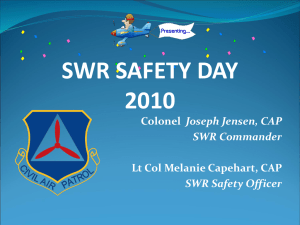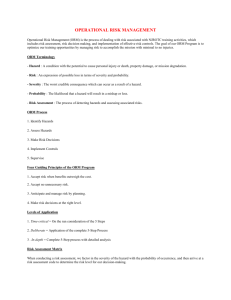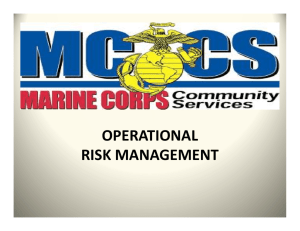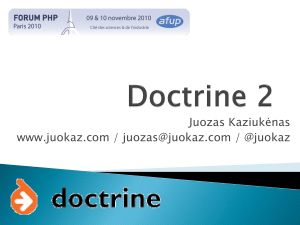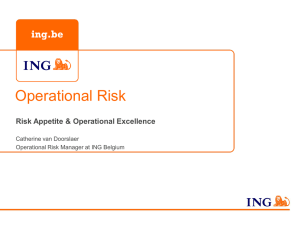AFI 90-901
advertisement
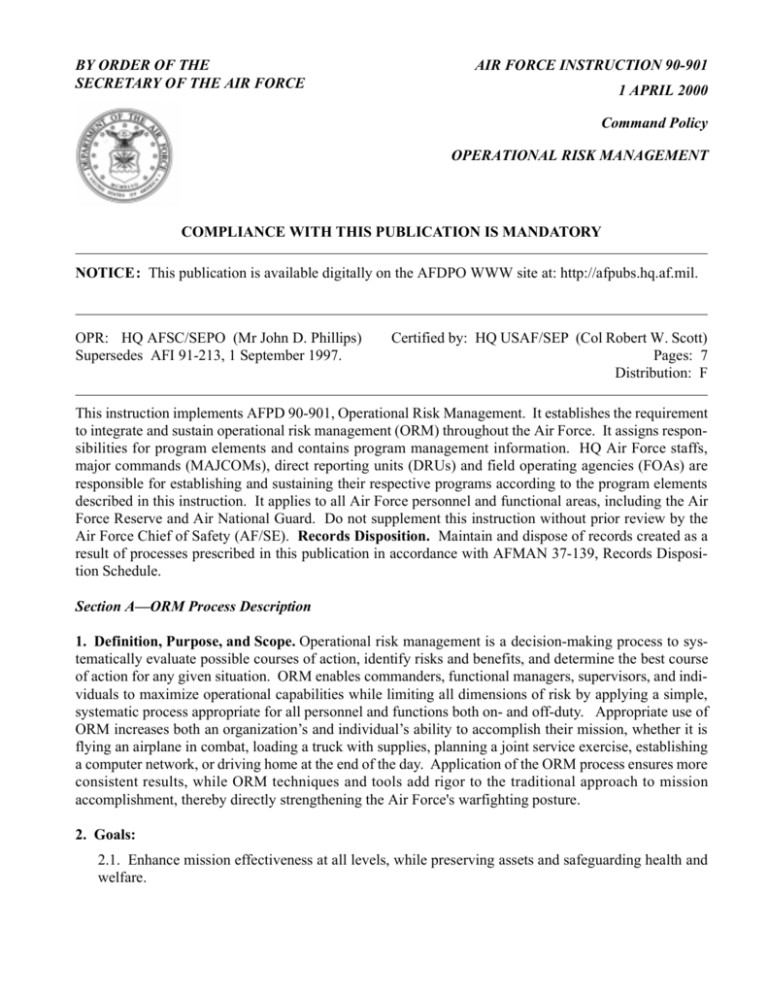
BY ORDER OF THE SECRETARY OF THE AIR FORCE AIR FORCE INSTRUCTION 90-901 1 APRIL 2000 Command Policy OPERATIONAL RISK MANAGEMENT COMPLIANCE WITH THIS PUBLICATION IS MANDATORY NOTICE: This publication is available digitally on the AFDPO WWW site at: http://afpubs.hq.af.mil. OPR: HQ AFSC/SEPO (Mr John D. Phillips) Supersedes AFI 91-213, 1 September 1997. Certified by: HQ USAF/SEP (Col Robert W. Scott) Pages: 7 Distribution: F This instruction implements AFPD 90-901, Operational Risk Management. It establishes the requirement to integrate and sustain operational risk management (ORM) throughout the Air Force. It assigns responsibilities for program elements and contains program management information. HQ Air Force staffs, major commands (MAJCOMs), direct reporting units (DRUs) and field operating agencies (FOAs) are responsible for establishing and sustaining their respective programs according to the program elements described in this instruction. It applies to all Air Force personnel and functional areas, including the Air Force Reserve and Air National Guard. Do not supplement this instruction without prior review by the Air Force Chief of Safety (AF/SE). Records Disposition. Maintain and dispose of records created as a result of processes prescribed in this publication in accordance with AFMAN 37-139, Records Disposition Schedule. Section A—ORM Process Description 1. Definition, Purpose, and Scope. Operational risk management is a decision-making process to systematically evaluate possible courses of action, identify risks and benefits, and determine the best course of action for any given situation. ORM enables commanders, functional managers, supervisors, and individuals to maximize operational capabilities while limiting all dimensions of risk by applying a simple, systematic process appropriate for all personnel and functions both on- and off-duty. Appropriate use of ORM increases both an organization’s and individual’s ability to accomplish their mission, whether it is flying an airplane in combat, loading a truck with supplies, planning a joint service exercise, establishing a computer network, or driving home at the end of the day. Application of the ORM process ensures more consistent results, while ORM techniques and tools add rigor to the traditional approach to mission accomplishment, thereby directly strengthening the Air Force's warfighting posture. 2. Goals: 2.1. Enhance mission effectiveness at all levels, while preserving assets and safeguarding health and welfare. 2 AFI90-901 1 APRIL 2000 2.2. Integrate ORM into mission processes, ensuring decisions are based upon assessments of risk integral to the activity and mission. 2.3. Create an Air Force in which every leader, airman, and employee is trained and motivated to manage risk in all their on- and off-duty activities. 2.4. Identify opportunities to increase Air Force warfighting effectiveness on the battlefield and in the operational aerospace environment, helping to ensure decisive victory in any future conflict at the least possible cost. 3. ORM Principles. Four principles govern all actions associated with the management of risk. These principles, continuously employed, are applicable before, during, and after all tasks and operations. 3.1. Accept no unnecessary risk. Unnecessary risk comes without a commensurate return in terms of real benefits or available opportunities. All Air Force missions and daily routines involve risk. The most logical choices for accomplishing a mission are those that meet all mission requirements while exposing personnel and resources to the lowest acceptable risk. 3.2. Make risk decisions at the appropriate level. Making risk decisions at the appropriate level establishes clear accountability. Those accountable for the success or failure of the mission must be included in the risk decision process. 3.3. Accept risk when benefits outweigh the costs . All potential benefits should be compared to all potential costs. The process of weighing risks against opportunities and benefits helps to maximize unit capability. Even high risk endeavors may be undertaken when there is a well founded basis to believe that the sum of the benefits exceeds the sum of the costs. 3.4. Integrate ORM into operations and planning at all levels. To effectively apply risk management, commanders must dedicate time and resources to integrate ORM principles into planning and operational processes. Risk assessments of operations are most mission supportive when they are done as a normal way of conducting a mission, not an add-on process performed by people not otherwise involved. 4. ORM Fundamentals. The essential concepts of Air Force ORM are outlined below. ORM: 4.1. Is a comprehensive system for improving individual and organizational performance in all functional areas and operations. 4.2. Should be tailored to meet the unique mission needs and operational requirements of each organization. 4.3. Provides the process and tools to develop and enhance awareness and understanding of at-risk activities and behavior of personnel both on- and off-duty. 4.4. Application may identify areas where regulatory guidance is overly restrictive or otherwise not consistent with mission requirements. In this event, the risk assessment may be used to support solicitation of appropriate level waiver, variance, or change, but will not in itself constitute authority to violate any directive, policy, standard, or other applicable regulatory guidance. 4.5. Is a continuous, systematic decision-making tool consisting of six steps that define the process. The following is a description of the six-step process. AFI90-901 1 APRIL 2000 3 4.5.1. Identify the Hazards . Step one of the process involves application of appropriate hazard identification techniques in order to identify hazards associated with the operation or activity. Hazard can be defined as any real or potential condition that can cause mission degradation. 4.5.2. Assess the Risk . The assessment step involves the application of quantitative or qualitative measures to determine the probability and severity of ill effects potentially resulting from exposure to a hazard. 4.5.3. Analyze Risk Control Measures . Step three involves the evaluation of specific strategies and controls that reduce or eliminate risk. Effective mitigation measures reduce one of the three components (probability, severity or exposure) of risk. 4.5.4. Make Control Decisions . Decisions are made at the appropriate level and are based upon analysis of overall costs and benefits. Decision-makers choose the most mission supportive risk controls consistent with ORM principles. 4.5.5. Implement Risk Controls . Once control measures have been selected, an implementation strategy must be developed and carried out. 4.5.6. Supervise and Review. Risk management is a process that continues throughout the life cycle of the system, mission, or activity. Leaders at every level must fulfill their respective roles in ensuring controls are sustained over time. Once controls are in place, the process must be periodically reevaluated to ensure their effectiveness and mission supportiveness. Section B—Program Management 5. Responsibilities. The following responsibilities are in addition to those defined by AFPD 90-9, Operational Risk Management. 5.1. Air Force ORM Steering Committee. An ORM steering committee will provide senior level cross-functional review and approval of Air Force ORM policy, requirements, and overall strategy. This committee will be co-chaired by the Air Force Assistant Vice Chief of Staff and the Deputy Assistant Secretary for Environment, Safety, and Occupational Health. Membership will include HQ USAF/DP/IL/JA/SC/SE/SG/ST/XO/XP, SAF/AQ/FM/IG/PA and the Air Force ORM Program Manager. Other HQ staff offices will serve as on-call members of the committee and will participate as required. The committee will meet at least annually. 5.2. Air Force ORM Integrated Process Team (IPT). An ORM IPT will develop the Air Force ORM policy, requirements, and overall strategy necessary to facilitate Air Force-wide integration and sustainment of ORM. The IPT will be chaired by the Air Force ORM Program Manager and is comprised of representatives from SAF/AQ/FM/IG/MI, HQ USAF/DP/IL/JA/SC/SE/SG/XO, and HQ AFDC. Other HQ USAF staffs will serve as on-call members of the IPT and will participate as required. The Air Force ORM IPT will report to the Air Force ORM Steering Committee. The IPT will meet at least semi-annually. Note: The IPT and any subgroups will be participant funded. 5.3. Air Force ORM Working Group. An ORM Working Group will assist the Air Force ORM IPT in developing the Air Force ORM policy, requirements, and overall strategy by identifying line organization requirements. The working group will also facilitate the exchange of crosstell and lessons-learned information between the commands. The working group will be chaired by the Air Force ORM Program Manager and comprised of representatives from each MAJCOM (including ANG), USAFA, AFOTEC, AFSFC, and AFCIC. Other DRUs and FOAs will serve as on-call mem- 4 AFI90-901 1 APRIL 2000 bers of the group and will participate as required. The Air Force ORM Working Group will report to the Air Force ORM IPT. The working group will meet at least semi-annually. Note: The working group and any subgroups will be participant funded. 5.4. SAF/AQ will ensure that acquisition guidance incorporates and links ORM; Operational Safety, Suitability, and Effectiveness; and System Safety principles and practices, to the extent that it is both possible and mission supportive. 5.5. SAF/FM will ensure fiscal guidance incorporates ORM principles, to the extent that it is both possible and mission supportive. 5.6. HQ USAF/XP will ensure the Air Force strategic plan and fiscal guidance incorporate ORM principles, to the extent that it is both possible and mission supportive. 5.7. HQ USAF/DP will provide guidance to integrate ORM process, principles, and techniques into training and educational programs to the extent that it is both possible and mission supportive to do so in consideration of the goals outlined in this instruction. 5.8. HQ USAF/SE and HQ Air Force Safety Center will: 5.8.1. Provide overall leadership and management of the Air Force ORM Program. 5.8.2. Develop and field generic ORM tools, education and training, guidance, and other initiatives necessary to support the Air Force-wide integration and sustainment of ORM. Note: HQ USAF staffs, MAJCOMs, DRUs, and FOAs will provide ORM tools, education and training, guidance, and other initiatives necessary to support ORM integration and sustainment specific to their organization or functional area. 5.9. HQ AFDC/CC will support the integration of ORM concepts and principles into new and existing doctrine, where mission supportive to do so, to induce and guide its application by warfighters. 5.10. Air Education and Training Command will ensure ORM education and training begins at accession and continues throughout a member’s technical and professional development. ORM education and training will begin with initial awareness and progress in a building-block manner that is supportive of the goals outlined in this AFI. 5.11. MAJCOM (including ANG), DRU, and FOA commanders will: 5.11.1. Serve as principal advocates for ORM and are key decision-makers in allocating assets to control risk and/or accept it when mission benefits dictate. 5.11.2. Appoint an ORM Program Manager who will develop command specific ORM policy, requirements, and overall strategy necessary to facilitate integration and sustainment of ORM within the command. This individual will interact with the Air Force ORM program manager to ensure continuity with the overall Air Force ORM program. 5.11.3. Ensure that inputs are provided to AETC for ORM related course development and integration. 5.11.4. Integrate ORM principles, concepts, and techniques into command level education and training programs (i.e., squadron commanders’ and supervisors’ courses). 5.11.5. Ensure that supervisors and unit level ORM advisors are properly educated and trained in ORM principles, concepts, and techniques. AFI90-901 1 APRIL 2000 5 5.12. Single Managers will: 5.12.1. Apply ORM principles and practices in the development and sustainment of weapon systems as part of the acquisition systems engineering process. Note that systems engineering refers to the application of ORM principles and practices as System Safety. 5.12.2. Provide, as part of the testing and fielding of a new or modified weapon system, information to the testers, operators, and maintainers on all identified hazards, implemented mitigation measures, and accepted residual risks. 5.12.3. Assist weapon system testers, operators, and maintainers in the application of ORM to those weapon systems, to include the assessment of hazards and potential mitigation measures. FRANCIS C. GIDEON, JR., Major General, USAF Chief of Safety 6 AFI90-901 1 APRIL 2000 Attachment 1 GLOSSARY OF REFERENCES AND SUPPORTING INFORMATION References AFPD 90-8, Environment, Safety, and Occupational Health AFPD 90-9, Operational Risk Management AFPD 91-2, Safety Program AFI 91-202, USAF Mishap Prevention Program Military Standard 882, System Safety Program Requirements. Abbreviations and Acronyms AFI—Air Force Instruction AFPD—Air Force Policy Directive ANG—Air National Guard DRU—Direct Reporting Unit FOA—Field Operating Agency HQ—Headquarters IPT—Integrated Process Team MAJCOM—Major Command ORM—Operational Risk Management PDO—Publications Distribution Office SAF—Secretary of the Air Force USAF—United States Air Force WWW—World-wide Web Terms ORM Advisor—Organization level ORM focal point who serves as advisor to commanders, managers, supervisors, and etc. on ORM policy, application, and training. Operational Risk Management (ORM)—The systematic process of identifying hazards, assessing risk, analyzing risk control options and measures, making control decisions, implementing control decisions, accepting residual risks, and supervising/reviewing the activity for effectiveness. Risk—The probability and severity of loss or adverse impact from exposure to various hazards. Risk Assessment—The process of detecting hazards and their causes, and systematically assessing the associated risks. System—A composite, at any level of complexity, of personnel, procedures, materials, tools, equipment, AFI90-901 1 APRIL 2000 7 facilities, and software. The elements of this composite entity are used together in the intended operational or support environment to perform a given task or achieve a specific mission requirement. System Safety—The application of engineering and management principles, criteria, and techniques to achieve acceptable mishap risk, within the constraints of operational effectiveness and suitability, time, and cost, throughout all phases of the system life cycle. (Military Standard 882D)
